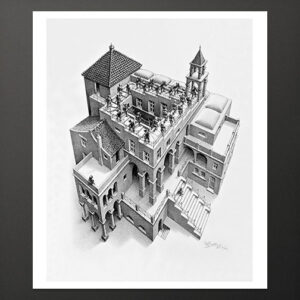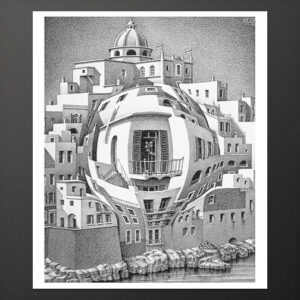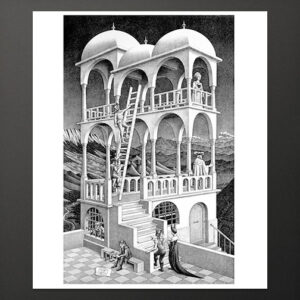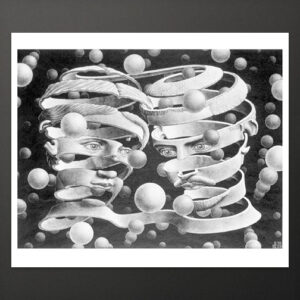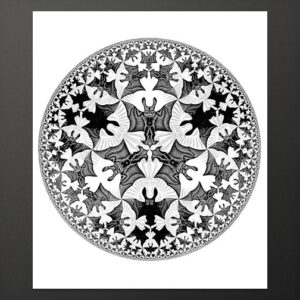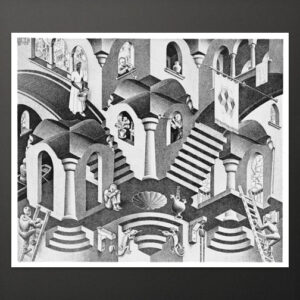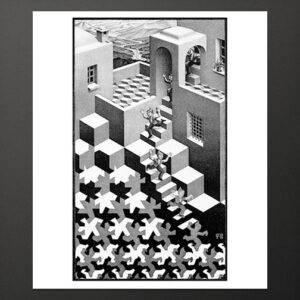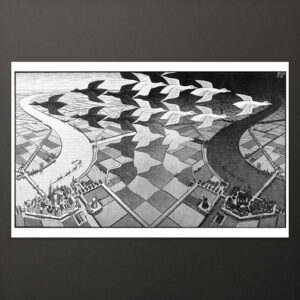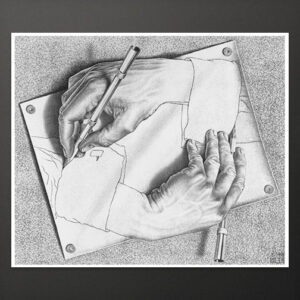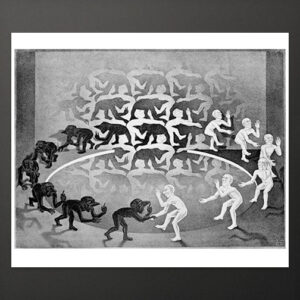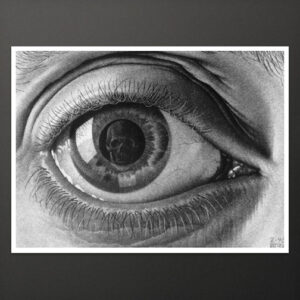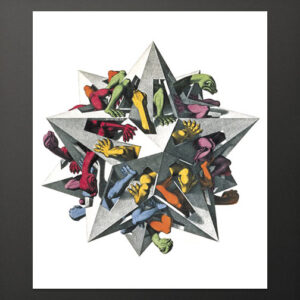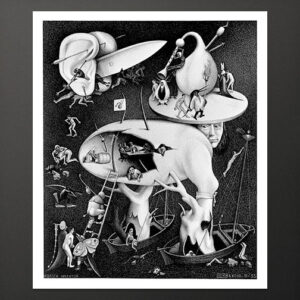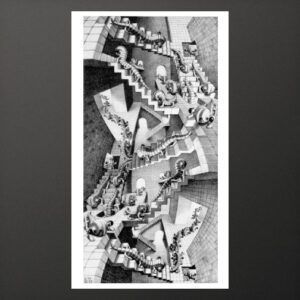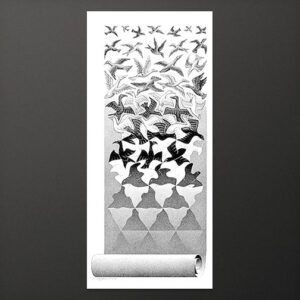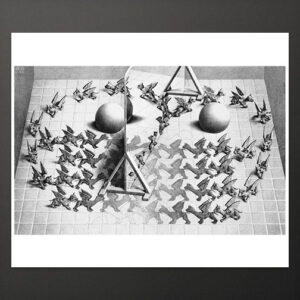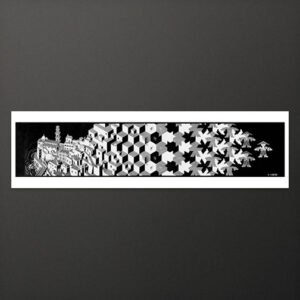-
Ascending and Descending, lithograph, 1960. "The endless staircase, that is the main motif of this imagery, was taken from an article by L.S. Penrose in the February 1958 issue of the British Journal of Psychology. A rectangular courtyard is bordered by a building that has an endless staircase as a roof covering. The inhabitants of this housing complex may well be monks, members of an unknown sect. It may be their ritual duty to climb this staircase for a few hours every day. When they are tired, they are apparently allowed to turn around and descend instead of climbing. But both directions, although meaningful, are equally restless. Two recalcitrant individuals refuse for the time being to participate in this exercise. They think what they want about it, but perhaps sooner or later they will see their error." ~ M.C. Escher, Grafiek en Tekeningen. Printed in black and white on poster paper. Paper size : 55 x 65 cm. Image size approx : 44,5 x 54 cm. Packaged in cardboard tube.
-
Printed in black and white on poster paper. Packaged in cardboard tube. Paper size : 55 x 65 cm. Image size approx : 46,5 x 58,7 cm.
-
Belvedere, lithograph, 1958 "In the foreground, bottom left, is a sheet of paper on which the edges of a cube have been drawn. Two circles indicate the places where edges cross each other. Which edge is in front, which is behind? Front and back at the same time is in a three -dimensional world is not possible and therefore cannot be depicted. But an object can be drawn that represents a different reality from above than from below. The boy sitting on the bench has such a cube-like absurdity in his hands. He looks thoughtfully at the impossible object and is apparently unaware that the belvedere behind him has been built in the same impossible way. On the floor of the lower platform, i.e. indoors, there is a ladder, along which two people are busy climbing. But when they arrive one floor higher, they are back in the open air and have to enter the building again. Is it any wonder that no one in the group cares about the fate of the prisoner in the basement, who puts his head through the bars, whimpering?" ~ M.C. Escher, Grafiek en Tekeningen. Printed in black and white on 170 gram paper. Paper size : 55 x 65 cm. Image size approx : 35 x 55 cm. Shipped in cardboard tube.
-
Bond of Union, lithograph, 1956. "Two spirals flow into each other and depict a woman's head on the left and a man's on the right. Like an endless ribbon, their foreheads intertwined, they form a unity. The spatial effect is enhanced by floating spheres, in front of, in and behind the hollow effigies." ~ M.C. Escher, Grafiek en Tekeningen. Printed in black and white on 170 gram paper. Paper size 65 x 55 cm. Image size approx : 58 x 43,7 cm. Shipped in cardboard tube.
-
Circle Limit IV (Heaven and Hell or Angels and Devils), woodcut of 2 blocks printed, 1960. "Here too, the components shrink from the inside out. The six largest, three white angels and three black devils, are arranged radially around the center. The disc is divided into six sectors, in which the angels on a black background and the devils on a white background alternately dominate. Heaven and hell alternate six times." ~ M.C. Escher, Grafiek en Tekeningen. Printed in black and white on 170gram paper. Paper size : 55 x 65 cm. Image size approx: 49,2 x 49,2 cm. Packaged in cardboard tube.
-
Convex and Concave, lithograph, 1955. "Next to each other are three houses with a cross vault as a roof. The left one is seen externally, the right one internally and the middle one optionally from inside or outside. There are several such inversions on this picture shown; one of them is described here. There are two boys playing the flute. One on the left looks down on the roof of the middle house; if he climbs through his window he can jump onto the roof below. If he then jumps down again, he ends up one floor lower on the dark floor in front of the house. However, the right flute player sees that same cross vault above his head as a roof before him there is no floor, but a fathomless abyss." ~ M.C. Escher, Graphics and Drawings. Printed in black and white on 170 grams poster paper. Paper size : 55 x 65 cm. Image size : 56 x 47 cm. Packaged in cardboard tube.
-
Cycle, lithograph, 1938. "At the top right, a cheerful boy emerges from his house. As he runs down the stairs, he loses his spatiality and ends up in a pattern of flat, gray, white and black peers. Counterclockwise upwards, these simplify into diamonds. The effect of depth is regained in the combination of three diamonds that are reminiscent of a cube. The cube connects to the house from which the boy emerges again. The floor of a terrace is covered with the same well-known pattern of diamond-shaped tiles. The view above is intended as a maximum of three-dimensional naturalness, while the periodic pattern from below shows a maximum of two-dimensional consistency." ~ M.C. Escher, Grafiek en Tekeningen. Printed in black and white on poster paper. Paper size : 55 x 65 cm. Image size approx : 32 x 54,5 cm. Packaged in cardboard tube.
-
Day and Night, woodcut of 2 blocks, 1938. "Gray rectangular fields develop upwards into silhouettes of white and black birds; the black ones fly to the left, the white ones to the right as two oppositely directed formations. On the left, the white ones flow into each other and unite into a daytime sky and landscape. On the right, the black ones merge into night. The day and night landscapes are each other's mirror images, which unite by means of gray fields, from which the birds develop again." ~ M.C. Escher, Grafiek en Tekeningen. Printed in black and white on poster paper. Paper size: 86,7 x 55 cm. Image size approx 78,5 x 45,5 cm. Packaged in cardboard tube.
-
Drawing Hands, lithograph, 1948. "A piece of paper is pinned to a surface with four drawing pins. A right hand is busy sketching the sleeve of a shirt on that drawing paper. The hand has not yet finished its work at that spot, but somewhat further to the right it has a left hand protruding from the sleeve, already depicted in such detail that it rises from the plane and in turn, like a living body part, outlines the sleeve from which the right hand emerges." M.C. Escher, Grafiek en Tekeningen. Printed in black and white on 170 gram paper. Paper size : 65 x 55 cm. Image size approx : 54,5 x 46 cm. Packaged in cardboard tube.
-
Encounter, lithograph, 1944. "From the gray edges of a back wall, a complicated pattern of white and black human figures develops. Since people who want to live need at least a floor to walk on, one was designed for them, with a circular hole in it, so that, as much of the back wall as possible, remains visible. As a result, they are also forced to walk in a circle and meet each other in the foreground: a white optimist and a black pessimist, who shake hands." ~ M.C. Escher, Grafiek en Tekeningen. Printed in black and white on 170 gram paper. Paper size : 65 x 55 cm. Image size approx : 55 x 39,7 cm. Packaged in cardboard tube.
-
Eye, mezzotint, 1946. "The artist has depicted his own eye here, greatly enlarged in a concave shaving mirror. The pupil reflects him who is looking at all of us." ~ M.C. Escher, Grafiek en Tekeningen. Printed in black and white on 170gram paper. Paper size : 55 x 40 cm. Image size approx : 43 x 32 cm. Packaged in cardboard tube.
-
Gravity, lithograph, hand-coloured, 1952. "Here is another star dodecahedron, bordered by twelve flat five-pointed stars. On each of these platforms lives a tailless monster with a long neck and four legs. Its torso is trapped under a five-sided pyramid with walls, each with an opening, through which the animal protrudes its head and legs. But the pointed end of a platform on which one animal lives is also the wall of the dungeon of one of its fellow sufferers. All these triangular ends therefore have the double function of a floor as a wall." ~ M.C. Escher, Grafiek en Tekeningen. Printed in color on poster paper. Paper size : 55 x 65 cm. Image size approx : 49 x 49cm. Packaged in cardboard tube.
-
Hand with Reflecting Sphere, lithograph, 1935. "A reflective sphere rests on the hand of the draftsman. He sees a much more complete picture of his surroundings in that mirror than through direct observation, because he sees almost the entire space around him: four walls, floor and ceiling of his room are , albeit distorted, compressed into that disk. His head, more precisely: the point right between his eyes, is in the center. No matter how he turns, he remains the center ." ~ M.C. Escher, Grafiek en Tekeningen. Printed in black and white on 170 gram paper. Paper size : 55 x 65 cm. Image size approx : 35,2 x 52,7 cm. Packaged in cardboard tube.
-
Printed in black and white on 170gram paper. Packaged in cardboard tube. Paper size : 55 x 65 cm. Image size approx : 44 x 51,7.
-
House of Stairs, lithograph, 1951. "A game element occurs that was already discussed in the regular division of the surface, the glide reflection. Almost the entire top half of the print is a mirror image of the bottom half. The top step, along which a creature descends from left to right, is even mirrored twice: in the middle and then again at the bottom. On the stairs in the upper right corner, the contrast between 'climbing' and 'descending' has been removed: two rows of animals go next to each other, but one rises and the other descends." ~ M.C. Escher, Grafiek en Tekeningen. Printed in black and white on 170grams paper. Packaged in cardboard tube. Paper size : 45 x 79,5 cm. Image size approx : 36,7 x 72,3 cm.
-
Liberation, lithograph, 1955. "On the uniform-gray surface of an unfurling strip of paper, a development takes place, from bottom to top, simultaneously in shape and contrast. Triangles, barely visible at first, turn into more complicated figures as their mutual color contrast increases. In the center they are completed as white and black birds. From here onwards they free themselves from each other and fly into the world as independent beings. That is why the paper strip on which they were drawn disappears." ~ M.C. Escher, Grafiek en Tekeningen. Printed in black and white on 170 gram paper. Paper size : 75 x 34 cm. Image size approx : 30 x 66 cm. Packaged in cardboard tube.
-
Magic mirror, lithograph, 1946. "On a tiled floor there is a vertically mirrored screen, from which a mythical creature is born. It emerges piece by piece until a complete animal walks away to the right. His reflection moves to the left, but remains real for a moment, because it emerges from behind the reflective screen into reality. First they walk in single file, then two by two and finally both streams meet each other in rows of four. At the same time they lose their plasticity. They slide together like pieces of a jigsaw puzzle, fill each other's spaces and identify with the floor on which the mirror stands." ~ M.C. Escher, Grafiek en Tekeningen. Printed in black and white on 170 gram paper. Paper size : 65 x 55 cm, image size approx : 55,5 x 34,5 cm. Packaged in cardboard tube.

